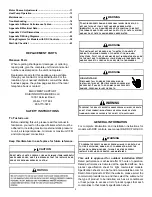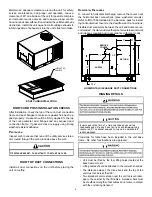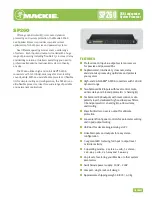
10
O
bstruCtiOns
, f
an
C
learanCe
and
w
iring
Remove any extraneous construction and shipping materi-
als that may be found during this procedure. Rotate all fans
manually to check for proper clearances and that they ro-
tate freely. Check for bolts and screws that may have jarred
loose during shipment to the job site. Retighten if neces-
sary. Re-tighten all electrical connections.
f
ield
d
uCt
C
OnneCtiOns
Verify that all duct connections are tight and that there is no
air bypass between supply and return.
f
ilter
s
eCtiOn
C
heCk
Remove filter section access panels and check that filters
are properly installed. Note airflow arrows on filter frames.
P
re
-
startuP
P
reCautiOns
It is important to your safety that the unit has been properly
grounded during installation. Check ground lug connec-
tion in main control box for tightness prior to closing circuit
breaker or disconnect switch. Verify that supply voltage on
line side of disconnect agrees with voltage on unit identifi
-
cation plate and is within the utilization voltage range as
indicated in Appendix B Electrical Data.
System Voltage
- That nominal voltage value assigned to
a circuit or system for the purpose of designating its voltage
class.
Nameplate Voltage
- That voltage assigned to a piece of
equipment for the purpose of designating its voltage class
and for the purpose of defining the minimum and maximum
voltage at which the equipment will operate.
Utilization Voltage
- The voltage of the line terminals of
the equipment at which the equipment must give fully sat-
isfactory performance. Once it is established that supply
voltage will be maintained within the utilization range under
all system conditions, check and calculate if an unbalanced
condition exists between phases. Calculate percent voltage
unbalance as follows:
Three Phase Models Only
3) PERCENT VOLTAGE
UNBALANCE
2) MAXIMUM VOLTAGE DEVIATIONS
FROM AVERAGE VOLTAGE
1) AVERAGE VOLTAGE
HOW TO USE THE FORMULA:
EXAMPLE: With voltage of 220, 216, and 213
1) Average Voltage = 220+216+213=649 / 3 = 216
2) Maximum Voltage Deviations from Average Voltage = 220 - 216 = 4
3) Percent Voltage Unbalance = 100 x
=
= 1.8%
Percent voltage unbalance MUST NOT exceed 2%
.
4
216
400
216
= 100 X
AIR FLOW ADJUSTMENTS
NOTE:
For 2 speed models, airflow adjustments must be
made on high speed, i.e., 2nd stage cooling or in heat mode.
Refer to “Motor Sheave Adjustments” section.
When the final adjustments are complete, the current draw
of the motor should be checked and compared to the full
load current rating of the motor. The amperage must not
exceed the service factor stamped on the motor nameplate.
The total airflow must not be less than that required for op
-
eration of the electric heaters or the furnace.
If an economizer is installed, check the unit operating bal-
ance with the economizer at full outside air and at minimum
outside air.
NOTE:
Never run CFM below 300 CFM per ton, evaporator
freezing or poor unit performance is possible.
e
vaPOratOr
f
an
r
OtatiOn
C
heCk
(t
hree
P
hase
m
Odels
O
nly
)
Check that fan rotates counter-clockwise when viewed from
the drive side of unit and in accordance with rotation arrow
shown on blower housing. If it does not, reverse the two
incoming power cables. In this case, repeat bearing check.
Do not attempt to change load side wiring. Internal wiring
assures all motors and compressors will rotate in correct di-
rection once evaporator fan motor rotation check has been
made.
e
leCtriCal
i
nPut
C
heCk
Make preliminary check of evaporator fan ampere draw and
verify that motor nameplate amps are not exceeded. A final
check of amp draw should be made upon completion of air
balancing of the duct system (see Appendix B).
BELT DRIVE MODELS ONLY
The drive on the supply fan is typically set in the middle
of the RPM range. The drive motor sheave pitch diameter
is field adjustable for the required airflow. Refer to “Motor
Sheave Adjustmens” section.
Upon completion of the air flow balancing, we recommend
replacing the variable pitched motor sheave with a proper-
ly-sized fixed sheave. A matching fixed sheave will provide
longer belt and bearing life and vibration free operation. Ini-
tially, it is best to have a variable pitched motor sheave for
the purpose of airflow balancing, but once the balance has
been achieved, fixed sheaves maintain alignment and min
-
imize vibration more effectively. For direct drive units, move
fan speed wire.
Содержание DCC Series
Страница 45: ...45 THIS PAGE INTENTIONALLY LEFT BLANK ...
Страница 46: ...46 THIS PAGE INTENTIONALLY LEFT BLANK ...
Страница 47: ...47 THIS PAGE INTENTIONALLY LEFT BLANK ...











































